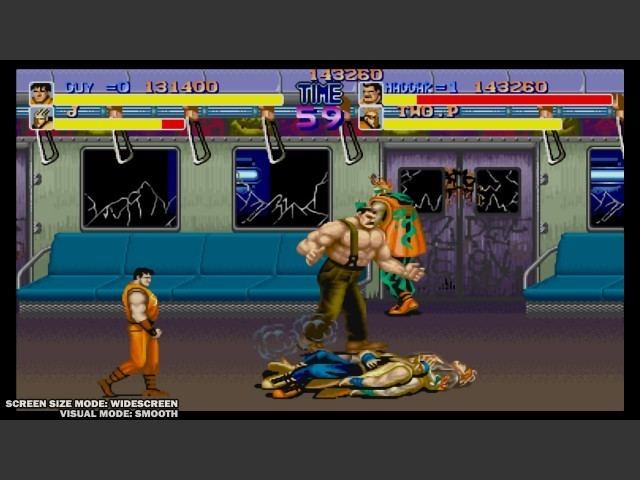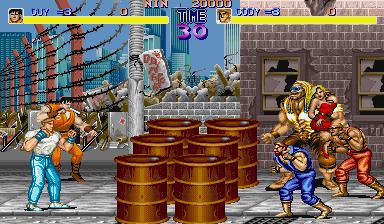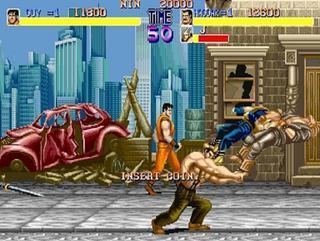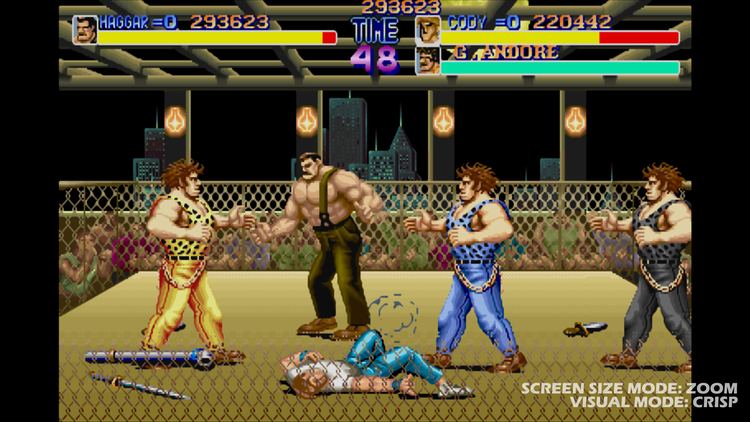Cabinet Upright | Initial release date December 1989 | |
 | ||
Designer(s) Akira NishitaniAkira Yasuda Composer(s) Manami MatsumaeYoshihiro SakaguchiYasuaki FujitaHiromitsu TakaokaYoko ShimomuraJunko TamiyaHarumi Fujita Mode(s) Single player, 2 player co-op Similar Final Fight games, Capcom games, Beat 'em up games | ||
Final Fight (Japanese: ファイナルファイト, Hepburn: Fainaru Faito) is a side-scrolling beat-'em-up video game produced by Capcom. Originally released as an arcade game in 1989, it was the seventh title released for the CP System hardware. Set in the fictional Metro City, the player controls one of three characters: former pro wrestler and mayor Mike Haggar, his daughter's boyfriend Cody, and Cody's best friend Guy, as they set out to defeat the Mad Gear gang and rescue Haggar's young daughter Jessica.
Contents
- Gameplay
- Plot
- Development
- Super NES Final Fight and Final Fight Guy
- US Gold versions
- X68000
- Mega CDSega CD Final Fight CD
- Game Boy Advance Final Fight One
- iOS
- Capcom Classics Collection
- Final Fight Streetwise
- Final Fight Double Impact
- Reception
- Legacy
- References

The game began development as a sequel to the original Street Fighter released in 1987, but the genre was switched from a fighting game to a beat 'em up and the title was changed following the success of Double Dragon. Final Fight was ported to various home consoles such as the Super NES and was followed by a few sequels. Its development team later worked on the original Street Fighter II and some of the characters from Final Fight later appeared as playable fighters in other entries of the franchise such as the Street Fighter Alpha sub-series.

Gameplay

Final Fight can be played by up to two players simultaneously. Before the game begins, the player chooses between the three main characters: Haggar, Cody, and Guy. Each has his own fighting style and attributes. Health gauges are displayed for both player and enemy characters.

The controls for Final Fight consist of an eight-way joystick and two buttons for attacking and jumping respectively. Pressing the attack button repeatedly when attacking an enemy or multiple enemies will cause the player character to perform a combo. The final blow of the combo can be changed to a throw if the player moves the joystick in the opposite direction just before landing it. The player can also perform jump attacks. Pressing the attack and jump buttons simultaneously allows the player to perform a special attack that strikes all surrounding enemies, but will drain a small portion of the player's health.

Enemies can be grabbed simply by walking into one of them. When an enemy is grabbed, the player can perform a grab attack by pressing the attack button or perform a throw by tilting the joystick left or right. A thrown enemy can be tossed at another for additional damage. Items such as weapons, health recovery items, and items awarding extra points can be picked up by standing over one and pressing the attack button. Weapons have limited uses and will disappear if the player is disarmed by an enemy too much or when the player moves to a new area.

Final Fight consists of six stages or "rounds", as well as two bonus rounds. Each round takes place in a different section of Metro City such as the Slums and the Subway, with most rounds featuring more than one level. At the end of each round the player will face a boss character unique to that round.
Plot
The game is set in a fictional city in the United States named Metro City. According to the game's intro, in 1990 (or 1989 in the Japanese version), the city's crime rate reached alarming levels. But since the election of pro wrestler turned politician Mike Haggar as the new Mayor, Metro City was changed and cleaned up drastically. Under his run, Haggar managed to suppress the crime rate of the city to its lowest points. While the citizens of Metro City were thankful for Haggar's hard work in curbing crime, one gang, the Mad Gear gang, would not go down so easily. Under the leadership of the crooked businessman, Belger, the group attempted to bribe Haggar with a large payoff to keep him from going after them, which Haggar refused. The Mad Gear responded by abducting his daughter, Jessica, and creating further unrest among the citizens of the city. When Haggar found out about his daughter's abduction, he becomes furious, and decides to take his fight against Mad Gear to a personal level. Seeking additional manpower, Haggar recruits Cody, an expert fighter and Jessica's boyfriend, as well as Guy, a ninja in training and Cody's good friend. Together, the three dedicate themselves to the complete eradication of the Mad Gear gang, as well as the safe rescue of Jessica from their clutches.
Development
Yoshiki Okamoto cites the arcade version of Double Dragon II: The Revenge as his basis for Final Fight. Final Fight was originally shown at trade shows under the title of Street Fighter '89. According to Okamoto, the sales division of Capcom originally requested a Street Fighter sequel, so his team decided to promote Final Fight as a Street Fighter sequel at trade shows (going as far to refer to one of the main characters as a "former Street Fighter"). The title was changed to Final Fight before its official release after feedback from operators stating that the game was nothing like Street Fighter.
According to the developers, many elements from the game and its plot were inspired by the 1984 film, Streets of Fire. Many members of the production staff are fans of the movie. One of the main characters from the game, Cody, was even inspired by the hero of the film, Tom Cody, who was played by actor Michael Paré. The story of the movie also dealt with the kidnapping of an attractive young woman by a city gang. The street gang the player faces in the game, the Mad Gear Gang, takes their name from a 1987 overhead racing game by Capcom of the same name. The game was released as Led Storm outside Japan. Many of the characters are named after 1980s rock musicians such as Axl Rose, Slash, Gene Simmons, (Sid) Sid Vicious, (Billy) Billy Idol, (Abigail, named after King Diamond's 2nd album and also dons facepaint similar to King Diamond) King Diamond, Roxy Music and Poison, with another being from the game Forgotten Worlds. Hugo Andore, another notable boss character, is based on Andre the Giant.
The soundtrack was the work of seven sound composers: Manami Matsumae, Yoshihiro Sakaguchi, Harumi Fujita, Junko Tamiya, Yasuaki Fujita (in his first work for Capcom), Hiromitsu Takaoka, and Yoko Shimomura. Despite this, Sakaguchi is the only composer credited in the game (as "Youkichan's Papa"). The other six were confirmed as having worked on Final Fight in 2014 when the Clarice Disk imprint of City Connection released the Final Fight Original Sound Collection, which featured the original soundtracks to the three original Final Fight games and its accompanying ports.
Super NES (Final Fight and Final Fight Guy)
A port of Final Fight for the Super Nintendo Entertainment System was released as a launch title for the platform in Japan in 1990 and later in North America in 1991 and then in the PAL region in 1992. It was released for the Wii's Virtual Console service in 2007 and the Wii U's Virtual Console in 2013. The SNES port removed the two-player co-op option, the Industrial Area level, and playable character Guy. Most of the scene transitions were also edited out. In the arcade version, the player characters would be seen exiting the levels and breaking through doors unlike the SNES version. Due to hardware limitations the SNES version could only display two or three enemies on-screen, in contrast to the CPS arcade version, which could display up to nine or ten enemies on-screen; to make up for this difference, the SNES version features more stopping points than the arcade version and the enemy placement is vastly different.
The English localization of the SNES port was censored for its content and features several differences from its Japanese Super Famicom counterpart: the first two bosses, Damnd and Sodom, were renamed Thrasher and Katana respectively; Belger's wheelchair was redrawn to look like an office chair; Poison an transsexual and Roxy a female redhead, were replaced with two male enemies named Billy and Sid; all alcoholic references were removed, with two health-recovering items replaced; the line "Oh! My God", spoken by an enemy when his car is destroyed during the first bonus stage, was changed to "Oh! My Car"; the blood splash effect shown when a character is stabbed is replaced by a generic explosion; and some of the darker skinned enemy characters were given lighter skin tones. The original soundtrack was ported for the Super NES by Toshio Kajino (credited as "Bull").
A revised edition of the SNES port, titled Final Fight Guy, was released in Japan in 1992. This version replaced Cody with Guy as a selectable character (with a new opening and ending sequence explaining Cody's absence), included four difficulty settings, and added other new features such as two new power-ups, although the Industrial Area stage and the Two-Player mode were still omitted. An American version of the game (featuring the same changes in the localization as in the first game) was released in June 1994 as a rental-only game that was initially available at Blockbuster stores, although it was later given a limited release. Kajino's music port was retained for that version.
U.S. Gold versions
U.S. Gold released ports of Final Fight for the Amiga, Atari ST, Commodore 64, ZX Spectrum and Amstrad CPC for the European market in 1991. These ports were developed by Creative Materials. In February 1993, the ZX Spectrum version was released as part of the Super Fighter compilation with Pit Fighter and WWF WrestleMania.
The ports received modest to poor reviews at the time with the general consensus nowadays being that the 8-Bit versions were just money grabs as a decent conversion would have been near impossible from the outset given the hardware limitations and that there was just far too much missing from the ports on the higher spec machines such as the Amiga and Atari ST.
X68000
The Sharp X68000 version was released by Capcom exclusively in Japan on July 17, 1992. This version is a relatively close conversion of the arcade game, with the only notable changes being different music (with a choice between a MIDI soundtrack and one using the X68000's internal sound chip) and a lower maximum on-screen enemies. The game came packaged with a CD soundtrack with all new remixed tunes.
Mega-CD/Sega CD (Final Fight CD)
The Mega-CD/Sega CD version, titled Final Fight CD, was ported and published by Sega under license from Capcom in 1993. This version retains nearly all the features of the arcade game that were removed in the two SNES ports (namely the two-player mode, the Industrial Area stage, and the ability to play as any of the three main characters) and adds voice acting to the game's opening and ending sequences, an arranged version of the original soundtrack, and an exclusive time attack mode. However the maximum number of on-screen enemies were still lower than the arcade version and the combo attacks of Cody and Guy are much slower. Furthermore, the graphics suffered from a more limited color palette, as well as fewer background details. Like the SNES version, the Mega-CD version was censored for the English localization with many of the same changes. Poison and Roxy were kept, but were redrawn with less revealing clothing.
Game Boy Advance (Final Fight One)
The Game Boy Advance version, titled Final Fight One, was released in 2001. Final Fight One features all three characters and the Industrial Area stage that was missing from the SNES version. The 2-player cooperative mode is also featured via link cable. Dialogue scenes prior to each boss battle have been added and the Street Fighter Alpha 3 renditions of Cody and Guy are featured as hidden playable characters. Other unlockable features include alternate palettes for each player character and the ability for two players to use the same character. The character and background designs are lifted from the SNES versions rather than the original arcade version, with the enemy placement being similar to Final Fight Guy, although the maximum number of on-screen enemies was increased and all the transition sequences were restored. The same new power-up items introduced in Final Fight Guy are also present in this version, along with a new Cody doll item. The English localization of the game featured the same changes as the two SNES versions.
iOS
On September 15, 2011, Final Fight was released into Apple's iTunes Store. This version includes all three characters from the Arcade version, a multiplayer feature that can only be used with Wi-Fi and a special items where one can turn on Extra Lives, Super Special, and Meat Explosion.
Capcom Classics Collection
Final Fight is included in the 2005 compilation Capcom Classics Collection Volume 1 for the PlayStation 2 and Xbox, and in the 2006 portable version Capcom Classics Collection Remixed for the PlayStation Portable. The game is emulated from the original CP System arcade version and features very little differences from the arcade game. The compilation includes tips, character profiles, an art gallery and a sound test as bonus features.
Final Fight: Streetwise
The arcade version is also included as a hidden bonus game in the 2006 game Final Fight: Streetwise for the PlayStation 2 and Xbox. However, the emulation in this version was programmed by Ultracade, rather than Digital Eclipse (the developers of Capcom Classics Collection series). The controls cannot be adjusted and the quality is lower than other emulated versions.
Final Fight: Double Impact
The arcade version of Final Fight was released in a two-in-one bundle titled Final Fight: Double Impact, alongside the arcade game Magic Sword, released digitally for Xbox 360 and PlayStation 3. Added features include various graphic filters, including an arcade cabinet view, online drop-in multiplayer, an arranged soundtrack composed by Simon Viklund (who worked on Bionic Commando Rearmed), and extra content such as concept art and comic pages which are unlocked by completing certain in-game challenges. The game was ported and developed by Proper Games and released for Xbox Live Arcade for 800 Microsoft points and April 15, 2010 for PlayStation Network for $9.99. The PS3 version features a very restrictive DRM protection which circumvents the ability other PSN games have to be shared among several PSN accounts. The DRM protection was met with a negative response as it had not been disclosed previous to the game's release. On March 27, 2012, Double Impact was released as part of the Capcom Digital Collection for the Xbox 360.
Reception
The game was acclaimed by critics. Mega magazine compared the Mega CD version of the game favorably against the incomplete and "poor" Super NES version, and placed it top of their list of the best Mega CD games of all time. The four reviewers of Electronic Gaming Monthly declared it a strong conversion of a game with "solid fighting action", though two of them also commented that "the necessity of the CD is questionable at best." On release of the Game Boy Advance version of the game, Famitsu magazine scored it a 31 out of 40.
In 1997, Nintendo Power ranked the SNES version as the 97th best game on any Nintendo platform. Retro Gamer included it among top ten Mega CD games, describing it as "arguably the best home console conversion (aside from recent emulated ports)" of "unquestionably the quintessential arcade hit of the late Eighties."
In the February 1991 issue of the Japanese coin-operated video game magazine Gamest, Final Fight took No. 1 spot as Best Game of 1990 in the 4th Annual Grand Prize. Final Fight also won the category of Best Action Game, placed No. 4 in Best Video Game Music, No. 9 in Best Graphics, No. 2 in Best Direction, and No. 5 in Best Album. The character Mike Haggar was displayed on the cover of this issue, who took the No. 1 spot in the Top 50 Characters of the year, with Guy in second place, Cody at No. 7, Poison at No. 26, Sodom at No. 33, and Jessica at No. 40.
Legacy
Final Fight was followed by a few sequels. The total sales of the Final Fight series have totaled 3.4 million units.
